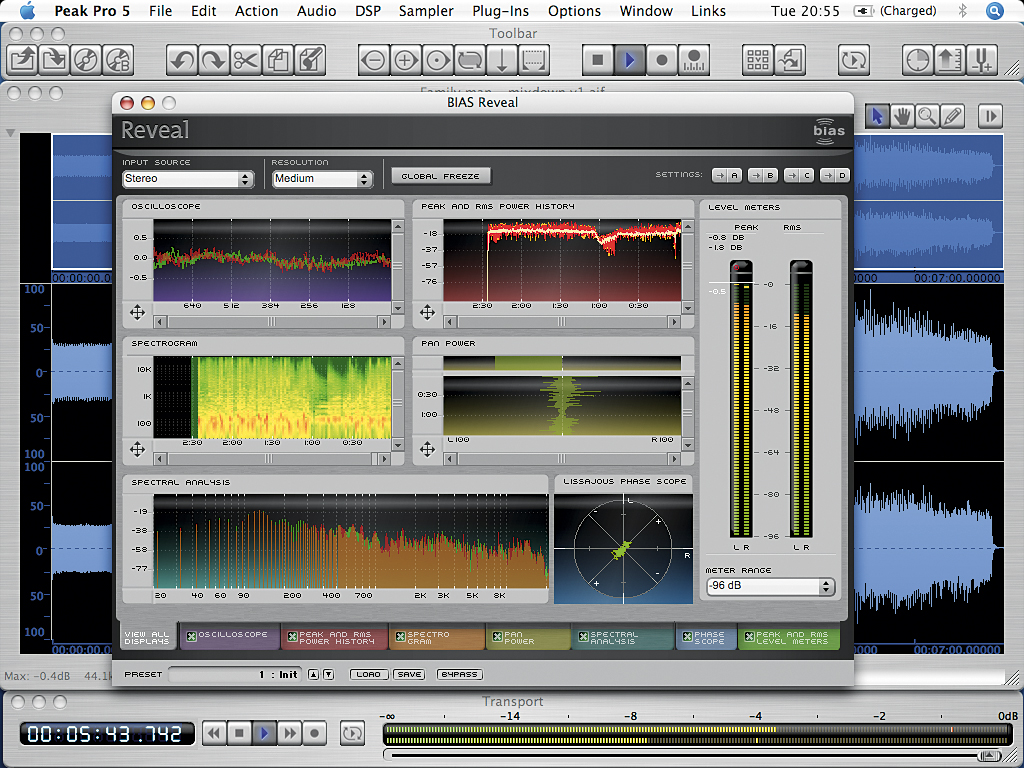MusicRadar Verdict
A very good update to the industry-standard Mac audio editor, but not an essential upgrade for all users.
Pros
- +
Feature packed. Great value for money. Excellent layout. Intuitive and easy to use. Impressive results.
Cons
- -
No real time audition of most DSP tools. Needs better limiter and exciter options (in Pro XT 5).
MusicRadar's got your back


Bias´ audio editing software is pretty standard in that it features a main editing display window that shows the separate stereo channels of your audio file running from left to right. You can zoom in and out on either axis, and by highlighting only the left or right channel, you can play back and process each one separately.
Situated above the main display is the Overview window, which enables quick and easy navigation. Clicking at any point on this or the main editing display triggers playback, and tape-style scrubbing is also on offer.
At the top of the screen is the Toolbar menu, which features pretty much all the standard editing controls you could think of (Cut, Edit, Paste, New marker, New region, etc). Finally, at the bottom of the screen are the Transport bar and the Level meter.
The top bar is where things really happen. Firstly, it´s here that you can access a multitude of high quality DSP effects, including time and pitchshifting, gain and all manner of other standard functions. Also on offer, though, are some much more interesting tools, including a rather special impulse response-fuelled reverb. In addition to the supplied impulses, this enables you to take a short section of any audio file and use it as an impulse. Results vary from incredible to absolutely crazy, but what a feature!
More tools
Peak isn´t just about chopping audio and sound design. A key feature is its ability to burn audio CDs, and you could think of it as a one-stop mastering shop. To burn a disc you simply need to create a Playlist document, and this can be made up of either separate audio files or even defined regions in your current open audio file.
A useful application for the latter is when you come to import live recordings or DJ sets into Peak: simply place markers at the start of each track, convert these to regions, create a Playlist document and add the regions to your playlist.
Want all the hottest music and gear news, reviews, deals, features and more, direct to your inbox? Sign up here.
You then have the option either to process the different tracks separately or together, and you can also shift the spacing of the tracks/regions on the timeline, creating crossfades if you wish. Very handy indeed.
Peak is also fully VST- and AU-compatible, and any such effects (and instruments) can be inserted and tweaked in real time. In addition, the rather tasty VBOX enables you to create groups of plug-ins in one handy controllable and patchable matrix.
Other sexy features include batch-processing (adventurous types can automatically apply a set of processing techniques from one file to many others), a very accurate Guess Tempo tool, an astoundingly well-laid-out Preferences section (with a brilliant key command setup interface) and even QuickTime and digital video support for putting audio to vi.deo. In fact, there´s far too much to list in full here
On the whole, Peak Pro XT 5 is a great little package, and fully deserves to be thought of as the best wave editor available for Mac.
Failings
So, what are Peak´s limitations? From a mastering point of view, the only real omissions are some better exciter and limiter options, but the software still has a few functional failings (the option to audition changes to DSP effects in real time would be nice).
It should also be noted that if you have no use for the audio-restoration tools and already have plenty of processing plug-ins, you should probably plump for the standalone version of Peak rather than the XT bundle reviewed here.
But what about current Peak users - should they upgrade? Well, sound designers will appreciate the enhanced DSP algorithms and revised VBOX facility, pro mastering engineers will be glad of the POW-r dithering in the Playlist and ISRC support, and live recording engineers will enjoy the facility to alter parameters when recording live through plug-ins.
However, if you´re using Peak 4 and are happy with it, it's probably not a good idea to go rushing out to buy the upgrade (though if you decide you simply have to have it, you won´t be disappointed). New users, on the other hand, can buy this in the knowledge that it´s the best audio editor the Mac has to offer.
MusicRadar is the number one website for music-makers of all kinds, be they guitarists, drummers, keyboard players, DJs or producers...
- GEAR: We help musicians find the best gear with top-ranking gear round-ups and high-quality, authoritative reviews by a wide team of highly experienced experts.
- TIPS: We also provide tuition, from bite-sized tips to advanced work-outs and guidance from recognised musicians and stars.
- STARS: We talk to musicians and stars about their creative processes, and the nuts and bolts of their gear and technique. We give fans an insight into the craft of music-making that no other music website can.
